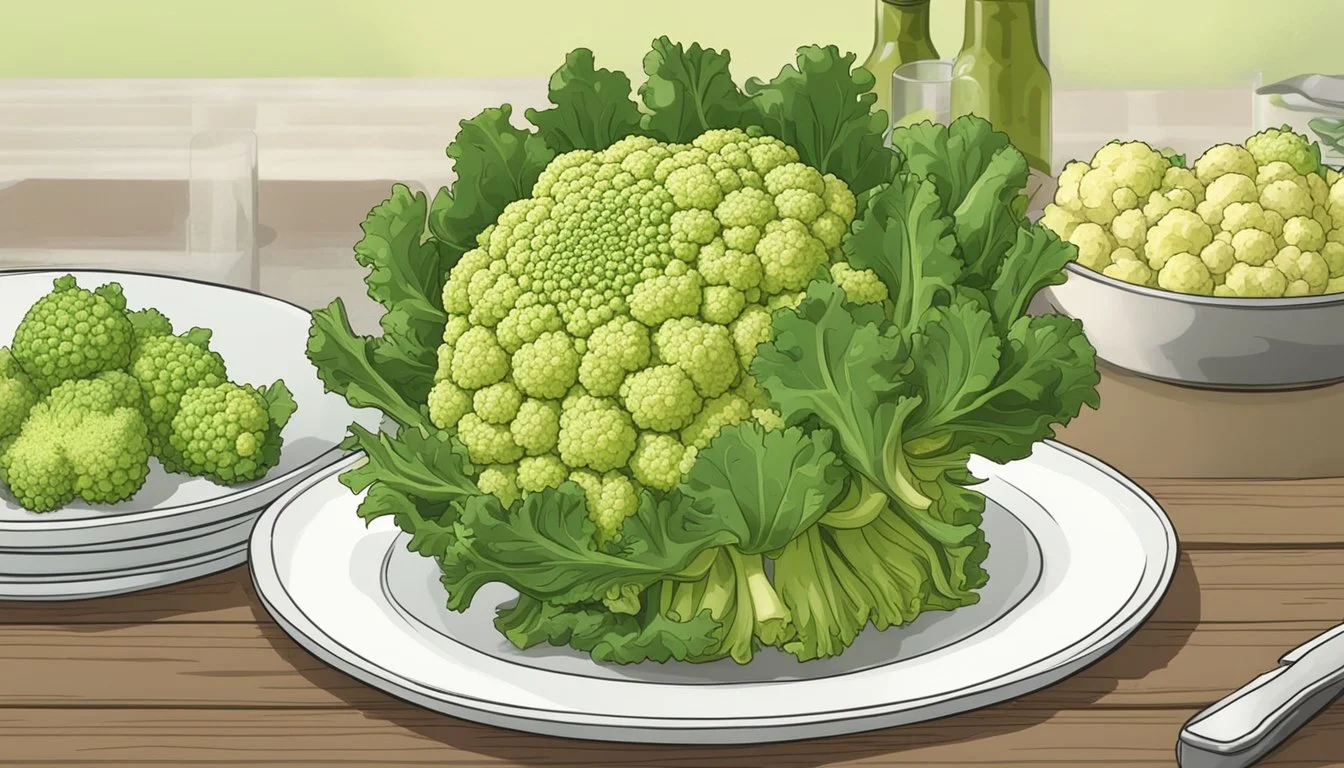How to Substitute Romanesco for Cauliflower
Simple Swap Guide
Romanesco, with its striking fractal pattern and vibrant green hue, offers not only visual appeal but also a unique taste and texture that stands as a testament to its culinary versatility. Often likened to cauliflower and broccoli, Romanesco can indeed substitute for cauliflower in almost any dish, bringing a delightful twist to familiar recipes. When cooked, its texture holds up well, mimicking that of cauliflower, while its flavor profile adds a subtle, earthy nuance that complements a wide range of ingredients.
Substituting Romanesco for cauliflower is a seamless process due to their similar structures and cooking methods. This vegetable can be prepared in a multitude of ways such as roasting, steaming, and sautéing. Its firmness and nutty undertones make it an excellent replacement in recipes that typically feature cauliflower, including stir-fries, pasta (What wine goes well with pasta?) dishes, and even as a base for a gluten-free pizza crust.
Those keen on experimenting with this vegetable will find that its cooking time is comparable to that of cauliflower. It's essential to avoid overcooking Romanesco to maintain its textural integrity and to preserve its distinct taste. Chefs may use it to introduce a new aesthetic and flavor dimension to their cuisine, ensuring that every dish not only satisfies the palate but also catches the eye.
Understanding Romanesco
Romanesco stands out in the cruciferous vegetable family due to its unique characteristics, often prompting comparisons with its relative, the cauliflower.
Defining Romanesco
Romanesco, sometimes referred to as Roman cauliflower or Romanesco broccoli, is an edible flower from the Brassicaceae family, which includes cauliflower and broccoli. It is notable for its striking chartreuse color and fractal shape, composed of a series of florets arranged in a logarithmic spiral. Each floret is shaped like a cone, with the structure repeating across the entire surface of the vegetable. The eccentric appearance of Romanesco is not just visually intriguing; it also embodies the Fibonacci number sequence, showcasing a harmony between nature, mathematics, and nutrition.
Comparing Romanesco and Cauliflower
Romanesco and cauliflower share many similarities, being part of the same family of vegetables. Both possess a densely packed head composed of multiple florets and have a similar overall texture when the florets are separated. However, despite their shared attributes, noticeable differences exist:
Color: Romanesco is typically a vibrant chartreuse, whereas cauliflower usually presents as a creamy white.
Texture: On the palate, Romanesco offers a firmer and more toothsome texture than cauliflower, with a slightly different mouthfeel.
Taste: Taste-wise, Romanesco provides a flavor akin to a milder broccoli with nutty and earthy tones, diverging from cauliflower's milder and subtler taste profile.
The two can often be used interchangeably in recipes, but it is important to take into account Romanesco’s unique texture and flavor, which can subtly alter the dish's final outcome.
Nutritional Profile
Romanesco can be an excellent substitute for cauliflower due to its similar nutritional profile. Both vegetables are known for being low in calories, making them ideal additions to a balanced diet. Romanesco specifically provides a visually striking alternative with its vibrant green color and fractal patterns.
Here is a comparison of their nutritional content per 100g serving:
Nutrient Romanesco Cauliflower Calories 25 kcal 25 kcal Saturated fat Trace amounts Trace amounts Unsaturated fat Trace amounts Trace amounts Sodium 22 mg 30 mg Carbohydrates 4.7 g 5 g Fiber 3.2 g 2 g Sugar 1.9 g 1.9 g Protein 2.1 g 1.9 g Vitamin C 69 mg 48.2 mg Dietary Fiber 3.2 g 2 g Cholesterol 0 mg 0 mg
Romanesco is particularly a good source of Vitamin C, essential for the immune system and skin health, with a slightly higher content than cauliflower. It also has a healthy dose of Dietary Fiber, which is beneficial for digestive health.
Although both vegetables contain sugar, the amounts are low and mostly come from natural sources within the plant. Their negligible fat content includes both saturated and unsaturated fats, but these are present in such small quantities that they have little impact on the overall nutrition of the vegetable.
Given its nutritional profile, Romanesco is a hearty substitute for cauliflower, offering similar health benefits, including a negligible amount of cholesterol. They can both be cooked in similar ways, such as steaming or roasting, to maintain their nutritional benefits.
Preparation Techniques
When substituting romanesco for cauliflower, the preparation techniques of cleaning, cutting, and basic cooking methods are vital to preserving its unique texture and flavor.
Cleaning and Cutting
To ensure that the romanesco is ready for cooking, start with a thorough cleaning. Wash the romanesco under cold water while gently separating the florets from the main stalk to remove any dirt or debris. Pat the florets dry before proceeding to cut them. When cutting romanesco, aim to create uniform pieces to ensure even cooking. Slice the florets at the base where they meet the stalk, then cut any particularly large florets in half to match the size of smaller ones.
Basic Cooking Methods
The basic cooking methods for romanesco are similar to those of cauliflower, providing a variety of dishes to savor the vegetable's earthy and slightly nutty flavor.
Roasting: Toss the romanesco florets with olive oil, sea salt, and desired seasoning such as minced garlic or red pepper flakes. Spread them out on a baking sheet and roast at 400 degrees Fahrenheit (204 degrees Celsius) for about 20-30 minutes, until the edges are crispy and golden. Adding lemon zest partway through the baking process can impart a fragrant citrus note, complementing the romanesco's flavor.
Sautéing: For a quicker preparation, romanesco can be sautéed. Heat olive oil in a pan over medium heat, and add the florets, stirring occasionally. Sauté for about 8-10 minutes. The romanesco should remain crunchy to the bite. To make garlic and lemon roasted romanesco cauliflower, sauté with crushed garlic and, right before serving, sprinkle with fresh lemon juice or zest for a burst of flavor.
In both cooking methods, ensure not to overcook the romanesco to maintain its signature texture. Romanesco, with its striking appearance and delightful flavor, can hold its own when substituted for cauliflower in any dish, whether it's an Italian sauce, a simple stir-fry, or served as a side with a crunchy, earthy presence on the plate.
Romanesco Substitution Guide
In culinary applications, Romanesco can be used as a seamless stand-in for cauliflower. Its unique geometric shape not only adds visual intrigue but also complements diverse dishes, offering a slightly different texture and flavor profile.
When to Substitute Romanesco for Cauliflower
Romanesco makes a fitting substitute in virtually any dish that calls for cauliflower. Its firm texture and nutty, slightly sweet flavor profile mean it can hold its own whether roasted, sautéed, or tossed into a salad. This striking vegetable is a versatile side dish that pairs well with ingredients like garlic, olive oil, and red pepper flakes for a simple yet flavorful addition to the meal.
Texture: Romanesco's texture is similar to that of cauliflower, but it tends to be slightly firmer when cooked, which can add a pleasant crunch to dishes.
Flavor Notes: It has an earthier and more pronounced taste than cauliflower, which should be considered when adjusting seasonings.
When serving Romanesco as a side, preparing it roasted with a coat of extra virgin olive oil, black pepper, and a sprinkle of sea salt can enhance its natural flavor. In soups, its creamy consistency when blended can rival that of cauliflower, providing a similarly smooth base. It's also an excellent addition to pasta dishes (What wine goes well with pasta dishes?), harmoniously melding with sauces to create a hearty meal.
Adjusting Recipes
When replacing cauliflower with Romanesco in recipes, a few slight adjustments will ensure the dish retains its desired characteristics.
Cooking Time: Romanesco may require a shorter cooking duration than cauliflower to prevent it from overcooking, as it is slightly more delicate.
Seasonings: Due to Romanesco's distinct flavor, one might want to reduce stronger spices or aromatics like garlic, or add a pinch more salt to balance the taste.
Consistency: If aiming for a creamy texture, such as in purées or sauces, ensure that Romanesco is adequately cooked to achieve smoothness.
A brief reference table for substituting Romanesco for cauliflower in common preparations:
Preparation Cauliflower Instructions Romanesco Adjustments Roasted 400°F for 20-25 minutes Slightly less time, check at 15 mins Sautéed Medium heat until golden Lesser time to maintain firmness In Soup Cook until soft May soften quicker; monitor closely In Pasta Boil 5-7 minutes Test for firmness at 5 minutes In Salad (Raw) Cut into florets Use as is for added texture
Always remember that while Romanesco can substitute for cauliflower, its unique qualities should be embraced to ensure your recipes stand out with their best flavor and presence.
Recipe Ideas
Romanesco can be a versatile ingredient, offering a touch of uniqueness with its fractal-shaped spirals and slightly nutty taste. Whether as a striking side dish or a main course, Romanesco is an easy substitute for cauliflower, often enriching the dish with its vibrant green hue and hearty texture.
Romanesco as a Side Dish
One can easily elevate their side dish game by introducing Garlic and Lemon Roasted Romanesco Cauliflower. This dish requires a short preparation time and simple ingredients like olive oil, lemon juice, and garlic to enhance the Romanesco's natural flavors.
Ingredients:
Romanesco, cut into florets
2 tablespoons olive oil
1 tablespoon lemon juice
3 cloves garlic, minced
Salt and pepper to taste
Instructions:
Preheat your oven to 400°F (204°C).
Toss Romanesco florets with olive oil, lemon juice, minced garlic, salt, and pepper.
Spread the florets evenly on a baking sheet.
Roast for 20-25 minutes or until golden and tender.
Alternatively, for a crunchy appetizer, Romanesco can be sautéed with olives, capers, (What wine goes well with capers?) and a sprinkle of breadcrumbs, making it a gluten-free and vegan-friendly treat.
Integrating into Main Dishes
In the realm of main dishes, Romanesco can be the star of a vegetarian Romanesco pasta dish. It pairs beautifully with pasta, adopting the role that cauliflower often plays in similar recipes. When tossed in a rich sauce such as pesto or a garlic and olive oil base, Romanesco soaks up the flavors while contributing a satisfying crunch.
Ingredients for Romanesco Pasta:
Cooked pasta of choice
Romanesco, cut into florets
1/4 cup pesto or olive oil with sautéed garlic
Optional: olives, nuts, parmesan cheese, and parsley for garnish
Instructions:
Cook pasta according to package instructions and set aside.
Sauté Romanesco florets until golden and add to cooked pasta.
Stir through pesto or a mixture of olive oil and sautéed garlic.
Garnish with optional ingredients like olives, nuts, and a sprinkle of parmesan cheese.
Both dishes showcase Romanesco's adaptability and how seamlessly it can be integrated into recipes typically calling for cauliflower, proving its worth as a delightful and nutritious alternative in any culinary repertoire.
Health Considerations
When substituting romanesco for cauliflower, individuals can expect a nutritious alternative that aligns well with various dietary needs, including low-calorie, gluten-free, and plant-based diets. This section delves into the binary choice of using romanesco instead of cauliflower and its dietary benefits.
Binary Choice of Romanesco
When faced with the decision between romanesco and cauliflower, one should consider their similar nutritional profiles. Both vegetables are low in calories and offer substantial dietary fiber, making them excellent choices for weight management. They are also gluten-free, making either a safe choice for individuals with celiac disease or gluten sensitivity. Additionally, romanesco and cauliflower are versatile and can be integrated easily into vegan and vegetarian diets.
Nutrients comparison:
Nutrient Romanesco (per 100g) Cauliflower (per 100g) Calories 25 25 Dietary Fiber 2.5g 2.0g Vitamin C 69% DV 77% DV
Dietary Benefits
Romanesco, much like cauliflower, is densely packed with essential nutrients that contribute to overall health. It is rich in magnesium, potassium, vitamin K, and vitamin C, which support bone health, immune function, and cardiovascular health. The dietary fiber present in romanesco aids digestion and has been associated with a lowered risk of various health conditions.
Key nutrients in romanesco:
Dietary Fiber: Supports healthy digestion and may lower the risk of colorectal cancer.
Vitamin C: Important for immune function and skin health.
Vitamin K: Plays a vital role in blood clotting and bone metabolism.
Magnesium and Potassium: Critical for muscle function and cardiovascular health.
One can confidently choose romanesco as a nutritious substitute for cauliflower without sacrificing health benefits.
Shopping and Storage Tips
When looking for romanesco to substitute for cauliflower in recipes, shoppers need to prioritize selecting high-quality produce and storing it correctly. The proper handling ensures the retention of its distinctive earthy and nutty flavor and maintains the structural integrity of its intricate florets.
Selecting the Best Romanesco
When purchasing romanesco, one should look for a vibrant green color, which indicates freshness and quality. The heads should be heavy for their size and the florets tight and intact, displaying the characteristic fractal pattern without any signs of wilting or browning. Farmers markets often provide the freshest options, allowing customers to source directly from the growers.
Storing Romanesco Properly
To extend its shelf life, romanesco should be stored in the refrigerator. First, wrap it loosely in a damp paper towel, then place it inside a plastic bag with small perforations for air circulation. This method can keep romanesco fresh for up to one week. For optimal flavor and texture, it's advisable to consume it within a few days after purchasing.
Serving Suggestions
When substituting Romanesco for cauliflower, one can employ its distinct fractal structure to enhance the presentation of dishes. A common approach is to roast Romanesco by tossing it in olive oil with garlic, black pepper, and sea salt. Roasting amplifies its natural nuttiness, making it a perfect side dish for Italian meals. As a table centerpiece, whole roasted Romanesco can be an eye-catching appetizer, especially when placed atop a spread of aromatic olive oil.
For a lighter option, Romanesco can be sautéed, preserving its vibrant green hue and providing a crisp-tender texture. Blending sautéed Romanesco into salads introduces diversity both in flavor and appearance. Drizzle lemon zest and olive oil to create a refreshing taste with a hint of citrus that contrasts its earthiness.
Pasta Pairing:
Sauce Enhancement: Romanesco's geometry adds an intriguing look to pasta dishes. Combine with a smooth sauce to let its shapes stand out.
Tossing with Heat: Briefly sauté with red pepper flakes, garlic, and a splash of lemon before mixing into pasta for a spicy kick.
Side Dishes and Salads:
Pureed into Sauces: Create a Romanesco-based sauce with a dash of Italian spices. Balance its intensity with sea salt.
Salad Addition: Chop into bite-sized pieces and incorporate into salads for a crunchy texture and unique look.
Nutritional Profile:
Rich in nutrients and low in saturated fat, Romanesco is a healthful addition to myriad dishes. Be mindful to use a reasonable amount of olive oil to maintain a healthy balance of fats.
Remember, the key is to respect the unique properties of Romanesco while being creative in its applications. Whether roasted, sautéed, or served raw, Romanesco can be a nutritious and visually appealing substitute for cauliflower.
Romanesco for Special Diets
Romanesco is a versatile vegetable that can be easily incorporated into various special diets. Its nutrient profile makes it suitable for gluten-free and vegan diets while also being a low-calorie choice for those watching their caloric intake.
Gluten-Free and Vegan Options
When one is looking to substitute cauliflower with romanesco in gluten-free and vegan diets, they can do so confidently. Romanesco contains no gluten and is entirely plant-based, making it an ideal ingredient for these diets. Individuals can use romanesco in a variety of dishes such as gluten-free pasta, salads, or soups, without the worry of deviating from dietary restrictions.
Pasta: Romanesco can be chopped and added to gluten-free pasta dishes for a nutritive boost.
Salad: A raw or lightly steamed romanesco adds crunch and fiber to vegan salads.
Soup: Pureeing romanesco creates a creamy soup base that is both vegan and gluten-free.
Low-Calorie Cooking
Romanesco stands out in low-calorie diets due to its low energy density. It is high in dietary fiber, which can aid in satiety and support weight management goals. Moreover, romanesco is low in saturated fat and cholesterol, benefiting those looking to maintain a heart-healthy diet.
Nutrition Values (per 100g):
Calories: Approximately 31
Saturated Fat: 0.1g
Cholesterol: 0mg
Fiber: 2.5g
A person can incorporate romanesco into their low-calorie diet by preparing it as a side dish or using it to bulk up meals with a high volume but minimal calories. One can also replace higher-calorie ingredients with romanesco in dishes like casseroles or stir-fries, reducing overall calorie content while still providing a satisfying meal.
Food Pairings and Combinations
The intricate, conical spirals of Romanesco make it a visual substitute for cauliflower, but its nutty flavor also pairs well with a variety of foods. Romanesco enhances dishes with its vibrantly green hue and offers tantalizing taste combinations for both meat-based and vegetarian meals.
Romanesco and Protein Pairings
Romanesco works harmoniously with various proteins, accentuating their flavors. It can be particularly delightful with nutty and rich proteins such as hazelnuts:
Grilled Chicken with Romanesco and Toasted Hazelnuts
Seared Salmon atop a bed of Romanesco laced with a hazelnut pesto
For a more traditional combination:
Roast Pork paired with Romanesco sautéed with apples and cabbage
Baked Cod served alongside Romanesco and olive tapenade
Vegetarian Dishes
In vegetarian cuisine, Romanesco proves to be versatile:
Romanesco and Kale Salad with a Lemon Vinaigrette
Pasta dishes with Romanesco, featuring ingredients like capers and olives
Additionally, Romanesco can star in:
Stir-fries, tossed with cabbage and garnished with nuts
Romanesco Pesto, blending the vegetable with garlic, nuts, and cheese for a spread or sauce
Conclusion
Using Romanesco as a substitute for cauliflower is both straightforward and adventurous. While both vegetables share a nutritional value profile high in fiber and essential vitamins, Romanesco brings a unique architectural beauty to the table with its intricate spirals that follow the Fibonacci sequence.
The application of Romanesco in recipes calling for cauliflower is seamless—chefs may replace it at a one-to-one ratio. Whether the dish is roasted, steamed, or sautéed, Romanesco's slightly earthy and nutty flavor complements a variety of flavor profiles.
For those concerned with presentation, Romanesco can offer an aesthetically pleasing upgrade with its vibrant green, spiky florets. Nutritionists often highlight the comparable nutritious advantages of Romanesco, making it a suitable and beneficial alternative.
Cauliflower Romanesco Mild flavor Nutty flavor Smooth texture Firmer texture White color Green color
When introducing Romanesco as a substitute, one should take care not to overcook it to preserve both its crunch and visual appeal. Overall, budgets and seasonal availability permitting, incorporating Romanesco offers a delightful twist to any recipe traditionally made with cauliflower, ensuring that dishes remain not only flavorful but also visually engaging.











